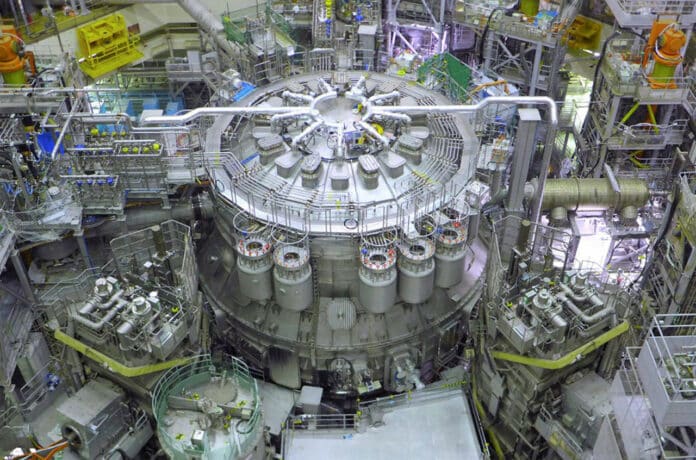A significant step forward in the quest for practical fusion energy was taken last week when the world’s newest and largest fusion reactor fired up.
Japan’s JT-60SA fusion reactor has produced its first plasma at the JT-60SA research facility, demonstrating the ability to generate a high-temperature cloud of ionized atoms. The research will advance to the next phase, which involves building and testing an experimental fusion reactor that can sustain plasma for long periods and extract useful energy from it.
Nuclear fusion reactions power the Sun and other stars. Nuclear fusion is the process of forcing together two light atomic nuclei and creating a heavier one, releasing enormous amounts of energy in the process.
On Earth, scientists are working to replicate this phenomenon and harness its potential for clean, safe, and abundant electricity production. Fusion energy could help meet the growing demand for energy from a rising global population while minimizing the environmental impact and ensuring long-term fuel availability.
The JT-60SA uses superconducting coils to generate magnetic fields that confine a blazingly hot plasma of ionized gas inside a doughnut-shaped vacuum vessel, where hydrogen nuclei can fuse and release energy. The four-story-high machine is designed to hold a plasma heated to 200 million degrees Celsius for about 100 seconds, much longer than previous large-scale tokamaks.
JT-60SA will also support ITER, the massive international fusion reactor being built in France that aims to demonstrate how fusion can generate more energy than goes into producing it. JT-60SA will test technologies and operating expertise that ITER will depend on. Until ITER turns on, Japan’s JT-60SA fusion reactor will be the largest in the world.
JT-60SA (SA stands for “super, advanced”) stands at 15.5 meters tall, which is about half the height of ITER. It can contain 135 cubic meters of plasma, one-sixth the volume of its European counterpart and roughly equivalent to a standard railroad tank car. Its plasmas should enable physicists to examine plasma stability and how it influences power output – lessons that can be transferred to ITER, says Alberto Loarte, chief of ITER’s science division.
One limitation is that JT-60SA will only use hydrogen and its isotope deuterium in its experiments, not tritium. Tritium is considered to be the most efficient option for energy production, but it is also expensive, scarce, and radioactive. ITER plans to begin using deuterium-tritium fuel in 2035 to capitalize on its efficiency.
The successful operation of JT-60SA last week “proves to the world that the machine fulfills its basic function,” according to Sam Davis, a project manager at Fusion for Energy, an EU organization working with Japan’s National Institutes for Quantum Science and Technology (QST) on JT-60SA and related programs. Hiroshi Shirai, the project leader for QST, says that it will take another two years before JT-60SA can produce the long-lasting plasmas required for meaningful physics experiments.
Japan also hopes to build DEMO by 2050. This demonstration fusion power plant would provide a stepping stone from the experimental research of JT-60SA and ITER to the commercial exploitation of fusion energy.
